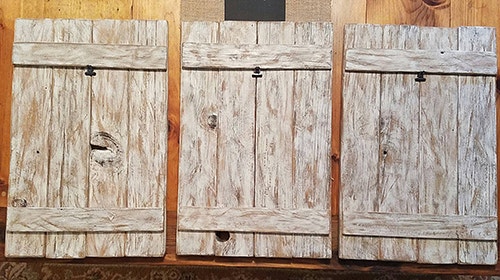Finish for Barn Wood?
I am making a TV stand out of 100-plus-year-old barn wood and wondered what you would suggest for a finish. - Don Templin
Chris Marshall: The rough, weathered look of old barn lumber is appealing, so I can see why you'd choose it for a piece of furniture. Just guessing here, but I bet you're leaving the gray or otherwise old surface of the wood intact. And, that time-earned "patina" is the reason why I'll offer this suggestion: leave the wood as is, with no finish on it whatsoever. Make the most of its character! When you think about it, that old barn wood stood up fine to anything and everything nature and farm life could throw at it. Covering that with a finish would probably make it easier to keep dusted and clean, but if you're prioritizing the original rough surface texture, there isn't a finish out there that's going to seal the weathered wood without also making it look oiled, shiny or otherwise coated. On the other hand, if your plan is to plane the lumber down smooth, then any shellac, varnish or lacquer will work fine. The surfaces will be flat again, so you can treat it as though you were finishing new wood. Which, in a sense, is what it will become.
Tim Inman: More than likely, you're wanting to use these old barn boards because of their aged and imperfect look - not because they might be a cheap source of lumber. But sometimes making something look "old and natural" isn't as easy as it might seem. First, there is the basic issue: These boards have lived in a barn - with animals - and with animal "stuff" for a long time. The look of an old barn might be charming; the smell of an old barn isn't. So, I would suggest a good power washing or soap and water cleaning first. Let the wood dry completely. Then, let's address the issue of color. Are the barn boards "right" for you? White? Red? Worn paint? Even though the boards may have the right patina, it can be "improved" or enhanced for your project. Consider freshening the colors. Working on a sealed and finished surface is much easier on the nerves when doing color adjustments. If you get it wrong, it is a simple thing to wipe away the offending paints. If you work on bare wood, forgiveness isn't so easy to come by. What sealer? Just about anything will do. Good old shellac is hard to beat. Dilute whatever you seal with, though. You are not trying to build a film coat at this stage. You just want to seal the wood to stop major absorption of paints, etc. When it is time to apply a final finish, I would suggest you go with a thin film of a dead flat material. This could be a varnish, or lacquer. Oils are OK, but they are very difficult to apply in a dead flat look. Dead flat will be more sympathetic to "old" looks. New things are bright and shiny, old things are dull and flat. I think my kids say that about me, too...Of course, please practice on scraps before you launch on your final work!
Keep the inspiration coming!
Subscribe to our newsletter for more woodworking tips and tricks



